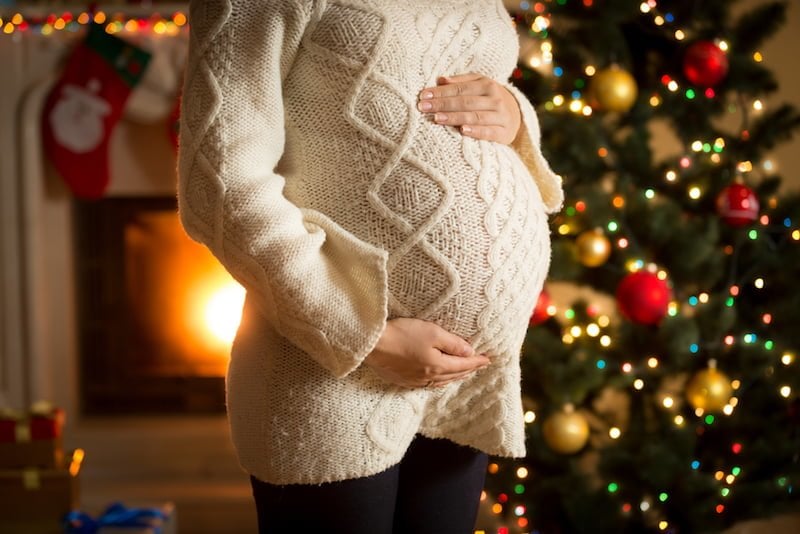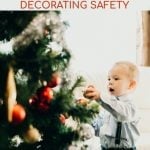Holiday Decorating Safety Tips for Pregnant Women & Families
Decorating for the holidays should be fun – especially when you add in the excitement of your expectation of a new little one.
But many moms-to-be don’t realize that decorations often contain hazardous and toxic chemicals. Naturally, you want the healthiest environment possible for your own body, and your baby’s developing brain and body, as toxins can cross the placenta.

Here are some holiday decorating safety tips to protect you, your unborn baby, and your whole family.
Holiday Light Safety
When it comes to holiday decorating safety, lights are a major concern. Unfortunately, they are loaded with lead. Lead is used in the PVC wiring to keep it from breaking down and cracking, and as well as a flame retardant.
In a study on lead in holiday lights, every brand tested contained levels high enough to cause damage to children (There is NO safe level of lead.) You can be exposed to lead by handling the lights, as well as from dust released into the air. IKEA lights as they have the lowest levels of lead available in the U.S. at this time (less than 1000 ppm.)
Pregnant women and children shouldn’t handle any Christmas lights at all. If you must, be sure to wash your hands immediately afterward and keep areas around the lights dusted well with a disposable wet cloth.
And if your little one arrives this season, please don’t wrap him or her in holiday lights for your holiday photos. Beyond the risk of lead exposure, glass bulbs can easily break and cut a baby or become a scary choking hazard. There’s also a risk of electric shock if baby puts the bulbs in his mouth. If those aren’t enough reasons, holiday lights can get hot enough to burn your child.
Decorative and Scented Candles
Candles nearly always contain paraffin and scented with chemicals called phthalates. Paraffin when burned releases toluene and benzene, which is linked to cancer, asthma and other health problems. Formaldehyde has been detected in the smoke coming from burning candles as well as the neurotoxin lead (even though it was supposed to be phased out of the wicks years ago).
Phthalates are often used to create the soothing scents from candles. Phthalates are endocrine disruptors that add to your overall chemical body burden and are linked to birth defects in boys and other health issues. These chemicals are also found in LED and fake candles that have scent.
The best way to create a scent in your home is to use essential oils or to purchase soy or beeswax candles scented with essential oils. These types of candles were found to not emit the chemicals.
Christmas Tree and Garland Chemicals
There are two different concerns to address with these Christmas classics: Lead and PVC in fake garland and trees as well as pesticides in real trees. (Find the answer to the eco-friendly debate of real vs. artificial trees here.)
Artificial Trees: More than 85% of fake trees and garland are made in China. Since they are made with PVC, they contain lead. In fact, in California, these trees are required to come with a warning label stating that they contain chemicals known to cause birth defects. We recommend avoiding artificial trees.
Real Trees: Real trees and garland are often coated with pesticides and herbicides. While some studies have stated that as much as 28 pounds of pesticides may be used for just one Christmas tree, other studies have shown it may be as little as ¼ an ounce. Quite a difference in results!
What we do know is toxic chemicals like Roundup are often used (in fact as high as 89% in 2006) as well as other chemicals that are known neurotoxins.
For the ultimate green tree, ask your local tree farm if they use pesticides and search for a pesticide-free tree and buy one that still has the roots. You can plant it when the holiday is over. If not, choose a cut tree that has not been treated with pesticides. The last option is to have someone else handle the tree and wash your hands after decorating to reduce pesticide exposure. You’ll also want to try your best to keep children from touching the tree.
Toxins in Holiday Ornaments
Molded plastic ornaments are known to emit a chemical called 1,2-DCA into the surrounding air. In fact, in one study it was found in all samples tested and levels of this chemical in the surrounding air were “cause for regulatory concern.”
This chemical is a linked to nervous system disorders, liver and kidney diseases, and lung effects. Other types of plastic ornaments may contain phthalates, lead or other chemicals. Try to buy safe metal ornaments, real wood, ceramic, or make your own!
Glitter Safety Issues
Glittery ornaments, cards, and decorations are a staple of the holidays. And everyone knows that glitter gets everywhere. It sticks to you, your kids, your pets… not to mention the floor and windowsills.
Glitter is made from large rolls of foil, plastics, or aluminum copolymers. It may contain mica, titanium dioxide, iron oxides or bismuth oxychloride.
If you read the material data form for glitter it does state “avoid contact with hands and mouth, use safety glasses, dust mask, and protective clothing as needed.” Since glitter manages to spread everywhere, try to keep it out of the house in the first place.

